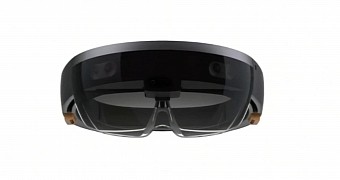2016 might be defined, at least in part, by the launch of the virtual reality headsets that have a chance to redefine the gaming industry, but it seems that Microsoft is also interested in making its own HoloLens device an interesting alternative.
The platform is focused on augmented reality, allowing users to experience their immediate reality as well as associated data and media content, and Bruce Harris, a technology evangelist at the company, says that the field of view delivered will be like one offered by a 15-inch monitor (38 centimeters) that the player sits about two feet (90.6 meters) away from.
The HoloLens will be wireless and can be used for about 5.5 hours on one charge under normal conditions, but the video also mentions heavy use that can reduce the autonomy to 2.5 hours.
According to the Microsoft representative, the connectivity options of the device will mean that it will stay linked to devices that are delivering content even if the user moves between rooms.
Bruce Harris also claims that his company is aiming to make the platform as affordable as possible for consumers, with the above-mentioned specifications designed specifically to make sure that there's a balance between performance and price.
Microsoft is at the moment exploring options for the manufacturing process for the HoloLens, which will have an impact on the launch date and the associated cost of the device.
The augmented reality platform will run on Windows 10 devices, and it seems that the specifications have not changed since early in 2015 when the official announcement was made, and gamers everywhere were impressed by the Minecraft-powered demo.
Since then, Microsoft developers have also shown how the HoloLens can be used to run other video games, including Halo 5: Guardians.
Augmented reality might be focused on commercial applications
The company has suggested in financial documents that it will first seek to convince big companies to use the HoloLens before developing gaming applications for it, although plans might change before launch takes place.
Augmented reality will have to compete with the coming virtual reality devices, which are expected to arrive before the middle of the year.
The Oculus Rift, which is priced at 599 dollars or 699 Euro, is at the moment ready for pre-orders, and there are some lucky customers who will get one in March, although the associated controllers have been delayed to later in 2016.
The biggest PC-based rival, the Vive, revealed a new development kit, and HTC and Valve will start taking pre-orders on February 29, when the official price will also be announced.
Sony is also working on its PlayStation VR solution, which can only be used by the PlayStation 4, but so far the company has not offered any details about the potential release date or the associated cost, although it said that it had more than 100 titles for it in development.
Both augmented and virtual reality have the potential to introduce new ways to experience video games, but they might be limited in their appeal initially by limited libraries and by high prices.

 14 DAY TRIAL //
14 DAY TRIAL // 